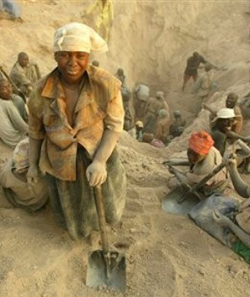Source: The New Internationalist
The last time I was in Zimbabwe I had an encounter with a local arts and crafts vendor who has a stall in one of Harare’s bustling flea markets. On this occasion he seemed disinterested in flaunting his archetypal Zimbabwean sculptures of mothers cradling their young or the clichéd soapstone wildlife roaming his rickety tabletop. He had become involved in the burgeoning diamond industry that had sprung up in an area of the Eastern Highlands of Zimbabwe called Marange District, where there are significant deposits of high-value industrial diamonds. He spoke of the astounding profit margins available to foreign buyers and how well he was doing as a middleman in this new venture. Inevitably, with the diamond trade’s crimson history, these stones were not being unearthed at a co-operative mine where the benefits enriched the soil from which they came. Rather, they brought with them increased violence and corruption to a people that know hardship and injustice all too well.

The situation in Chiadzwa (the specific area where the mines are located) is riddled with illegality and violence. Firstly, at the time of the diamond rush in 2006, the mining rights had been privately owned by African Consolidated Resources (ACR). However their contract was ‘cancelled’ by Government which then effectively declared the mines a free-for-all, thus encouraging illegal mining and smuggling. What followed was an increased police presence and the formation of diamond syndicates that they ran with the illegal panners. This culminated in the gruesome events of November 2008, which received minimal international media attention. According to early reports, over 200 innocent miners were thought to have been gunned down. Some further examinations suggest that the number is closer to 400. This was a result of an Army operation known as ‘Harudzokwai’, or ‘No Return’, when soldiers descended on the mines without warning in helicopters and on foot shooting the fleeing miners.
Aside from the murders and other atrocities, this was hugely illegal as, ordinarily, the military should not take charge of civilian operations. A report from Human Rights Watch explains how the decision had to have been recognized and approved by the Commander-In-Chief of the Armed forces: President Robert Mugabe. Earlier that year soldiers had rioted in the Capital and the military saw dwindling numbers in its ranks. It is widely held that control over the mines have served to quell falling recruitment numbers and bolster the ruling party. This is a reaction reminiscent of the farm invasions in 2000, when land was sacrificed in order to appease the protestations of disgruntled war veterans. The military and their political affiliates have subsequently used the forced labour of locals, including children, and created diamond syndicates of their own which have become scandalously lucrative. There have been numerous reports, including hundreds of eye-witness testimonies, confirming atrocities perpetrated by soldiers against locals including rape, torture, forced labour and murder. As to be expected, the Government is operating a ‘hear no evil, see no evil’ policy and the presence of soldiers is allegedly for the sole purpose of security.
Some international diamond suppliers have begun withdrawals of the Chiadzwa diamonds from their networks and the Kimberley Process, which was set up to quell the distribution of conflict diamonds, has been investigating the events in Chiadzwa. Yet one only needs to look over the border to a small town called Villa de Manica in neighbouring Mozambique where illegal trade and smuggling is flourishing. New houses have popped up, dotting the skyline with purples and yellows; not the most inconspicuous of shades. Dealers have come from West Africa, Angola and as far as Lebanon to gather diamonds and push them into the international market. The problem with diamonds is that once the rough stones have been polished it is impossible to tell where they were sourced.
Whilst the Government is willing to allow this precious asset to be syphoned out of the back door, or into their back pockets, there has been increased pressure from local and international organizations calling for transparency and correct management; two things seldom found in Zimbabwean governance. One of the key local groups investigating the unfolding events in Chiadzwa is the Centre for Research and Development, which has been extremely critical of Government’s approach to the situation. It is estimated that the Chiadzwa diamonds, if managed properly, could bring in US$200 million per month – an astonishing figure considering the abysmal state of the economy. It seems unlikely that Government initiative, as opposed to external pressure, this new year will bring much resolution to this grave betrayal of a country and its people. Numerous corporate and private court cases have emerged surrounding Chiadzwa. This, along with pressure from NGOs and the aforementioned international grumblings, are signs of the Government’s arm being twisted into addressing the situation to an extent. One of these cases was filed against the Government and won by ACR, who originally owned the land, yet this ruling élite is one with numerous charges held against it that it chooses to ignore. Until the rule of law is restored, and a legitimate government operates in Zimbabwe, dissenting voices will have to speak out against more of these miscarriages of justice perpetrated by Zimbabwe’s infamous ruling cartel.
Dikson worked as a New Internationalist campaigner before recently returning to Zimbabwe. Read more about Dikson M.
